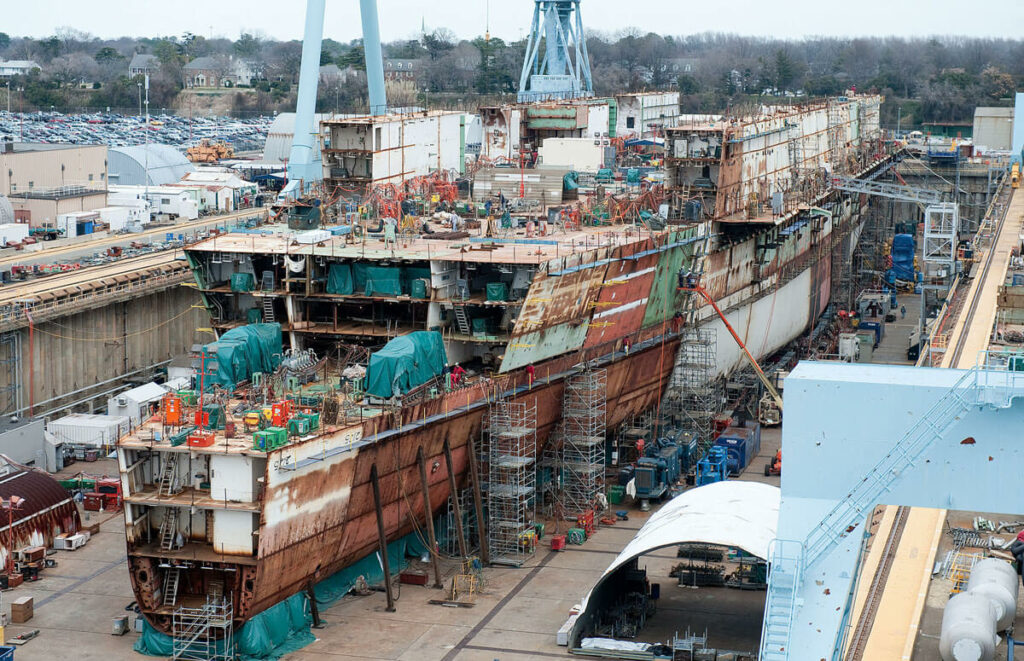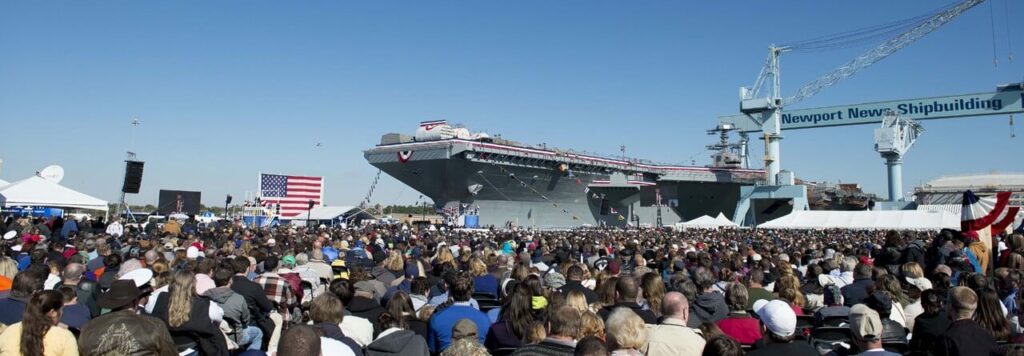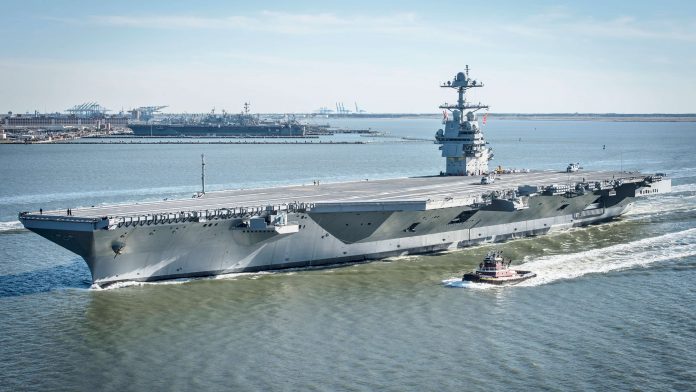Named after the 38th President of the United States, the Gerald R Ford-class ‘supercarriers’ are set to spearhead the United States Navy’s sea-deployed airpower in coming years.
The first all-new US Navy aircraft carrier designs since the USS Nimitz (CVN-68), leadship USS Gerald R. Ford (CVN-78) and its brethren will have 50-year service lives. More capable and efficient than any of their predecessors, they’ll be highly protected, extensively-armed ‘floating islands’ that launch aircraft – manned and unmanned – with unprecedented speed.
As a US Navy fact sheet states: ‘Gerald R Ford class aircraft carriers and carrier strike groups will provide the core capabilities of forward presence, deterrence, sea control, power projection, maritime security and humanitarian assistance. The class brings improved warfighting capability, quality of life improvements for our Sailors and reduced total ownership costs.’
USS Gerald R Ford Development
The Nimitz-class supercarriers have been the US Navy’s maritime capabilities bedrock for decades but they have finite service lives: USS Nimitz itself will be fifty years old by the mid-2020s. Work on the USS Enterprise and Nimitz-class’s replacement was underway by the mid-2000s. For the first time, 3D computer design tools were used to model every single USS Gerald R Ford part. With absolutely no space wasted, this process reportedly made this ship the most efficient carrier design ever. It’s expected that as a result of this design approach, associated maintenance requirements will drop 30 per cent.

Features
1,106 feet (337 metres long, the USS Gerald R Ford is 134 feet (41 metres) wide at the waterline but has a 256 foot (78 metre)-wide flight deck. When at its heaviest, it displaces almost 100,000 tons of water – a weight load equivalent to that of 400 Statues of Liberty! On all fronts, this massive carrier’s statistics impress.
Outside, for example, it wears no less than 200,000 gallons of Haze Grey paint – enough to cover the White House 350 times over. Across the entire ship, there are approximately 44,000 energy-efficient T-8 light bulbs in place. These light bulbs provide greater luminescence and have a longer lifespan than those used before.
Flight deck space is much increased over that of the USS Nimitz thanks to a scaled-down island positioned 140 feet (43 metres) further back and there are now three aircraft elevators – not four. These make a more efficient business of raising/lowering aircraft up from/into the hangar area. Staying inside the USS Gerald R Ford, there are an amazing 10 million feet (three-plus million metres) of cables installed that, if stretched out end-to-end, would link Washington DC and New Mexico. Also present are four million feet (1.2 million metres) of optic cables while the carrier’s general internal layout is designed to be flexible enough that it can be quickly modified for particular missions.
Sailors And Aircraft
2,600 sailors will make up the USS Gerald R. Ford’s ships’ company – around 600 less than crew the USS Nimitz. These will be supplemented by about 2,000 more naval aviators, meaning that the carrier will typically deploy with around 4,600 people on board. The USS Nimitz, in contrast, deploys with over 1,000 more – a differential that’s predicted to produce $4bn in manpower savings across the new carrier’s projected fifty-year lifespan.
The USS Gerald R Ford has the capacity to accommodate up to 75 aircraft. Operationally, it will be loaded with Boeing F/A-18E/F Super Hornet multirole fighters and EA-18G Growler electronic warfare aircraft, Grumman C-2A Greyhound COD (carrier onboard delivery) aircraft, Northrop Grumman E-2D Hawkeye AEW&C (airborne early warning and control) aircraft, Lockheed Martin F-35C Lightning II stealth multirole fighters and Sikorsky SH-60 Seahawk naval helicopters. It will also carry Northrop Grumman X-47B-type unmanned strike aircraft and, potentially, other UAVs.
USS Gerald R Ford Capabilities
The USS Gerald R Ford will have a top speed of some 35 miles per hour (56 kilometres per hour) and a technically unlimited range, though maintenance will need to be performed at regular intervals. It’s designed to be able to launch 160 sorties each day, for days on end, but could ramp up this operational tempo to a staggering 270 sorties a day in especially demanding circumstances. Even that lower sortie level represents about a 25 per cent increase on the USS Nimitz’ maximum.

The ship will be armed with RIM-162 Evolved Sea Sparrow and RIM-116 Rolling Airframe missiles, plus the CIWS Close-in Weapon System. The RIM-162 ESSM is a medium-range RIM-7 Sea Sparrow surface-to-air missile development first fielded in early 2004. Designed to engage anti-ship missiles and low-flying aircraft, it has a top speed of Mach 4-plus and a 50-plus kilometre range. The RIM-116 RAM is unique among current US Navy missiles because it rolls, in-flight, to keep itself stable. Introduced in 1992, it travels at speeds of Mach 2-plus and has a 5.6 kilometre range in its Block 1 form. The Close-In Weapon System is a computer-operated gun and radar combine that fires rounds at a rate of 2,000 per minute and can cover a 3.6 kilometre range.
|
Role: |
Supercarrier |
|
Length: |
1,106 feet (337 metres) |
|
Width: |
256 feet (78 metres) |
|
Engines: |
Two Bechtel A1B nuclear reactors |
|
Maximum speed: |
35 mph (56 km/h) |
|
Maximum range: |
Unlimited |
|
Crew: |
2,600 personnel, plus around 2,000 aircrew |
|
Weapons: |
RIM-162 ESSMs, RIM-116 RAMs, CIWS |
|
First launched: |
11 October 2013 |

















































